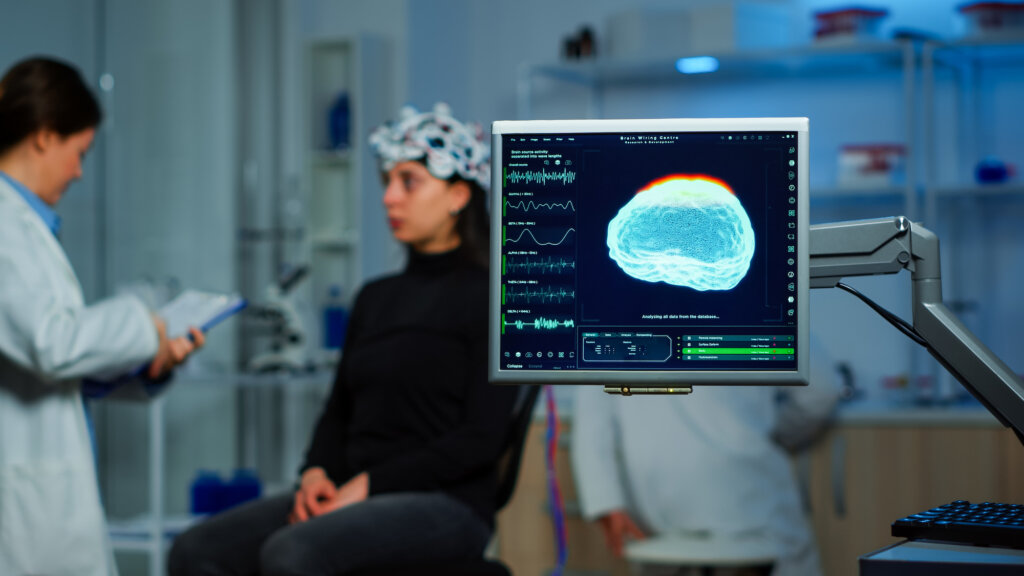Telepathy Experiments in Silicon Valley


Reviewed and approved by the psychologist Sergio De Dios González
The telepathy experiments they’re conducting in Silicon Valley have nothing to do with parapsychology or the occult. In fact, in this case, they involve brain-machine interfaces that allow people to communicate directly through thought. Experts claim that we’re only one step away from achieving it.
Although several telepathy tests are currently being carried out in the Californian region, the best known and most advanced is undeniably the one led by Mary Lou Jepsen, former Facebook and Google executive and creator of a startup called Openwater. This genius has been working on the subject since 2016 and she’s made remarkable progress.
Jepsen enjoys great prestige in the technological world. One reason is that she owns more than 1,000 patents. In fact, she was the creator of the most popular laptop/notebook among children in developing countries. She achieved this via the One Laptop per Child program. They say her hobby is betting on the impossible. Moreover, she’s currently the most prestigious researcher of all those conducting telepathy experiments in Silicon Valley.
“You’re going to just be able to capture a thought, what you’re thinking and feeling in kind of its ideal and perfect form in your head, and be able to share that with the world in a format where they can get that. There’s some pretty crazy brain research going on that suggests we might be able to do this at some point.”
-Mark Zuckerberg-
A relevant background
One of the decisive precedents for telepathy studies in Silicon Valley was conducted by a Barcelona startup in 2014. The prestigious scientific journal, Plos One, published a description of this experiment.
The investigation was led by Carles Grau, Alejandro Riera, and Giulio Ruffini. In collaboration with Axilum Robotics staff, they connected a device to a transmitter located in Strasbourg. The recipient also had a similar device and was located in the Indian town of Thiruvananthapuram. They were separated by 7,700 kilometers.
The research group managed to get the sender to send a message to the receiver without saying a word. The word used was “Hello”. In effect, the brains were connected, which constitutes telepathic communication in the strict sense of the word. This became one of the reference points for Silicon Valley.

Telepathy experiments in Silicon Valley
The basic idea of Openwater is simple, yet extremely bold. It consists of reducing the size of an MRI machine until it can fit into a hat. It’s based on the idea that the infrared rays from this type of device allow us to study the functioning of neurons and the electrical flow with which they communicate.
Jepsen argues that such a device would allow us to anticipate the words an individual will say before they say them. We’d also see the mental images of that person through a computer.
In principle, this would make it possible to read someone’s thoughts. That said, the telepathy experimentation in Silicon Valley goes further. In fact, they’re also seeking to make it possible to transmit mental messages. This process is ongoing.
There are also more telepathy explorations being conducted in Silicon Valley. One of them is the initiative of Elon Musk. It’s called Neuralink. It works through implants called BCI – Brain Computer Interface. Facebook has also revealed that it’s working on a method for people to type with their minds.

The future
Mary Lou Jepsen’s hat is almost ready, although there hasn’t yet been a definitive solution for the telepathic transmission of messages. Currently, they’re perfecting the mechanism to read a person’s mind without them saying a word. However, at the moment, it’s another mind that reads the thoughts and not a computer.
There’s another group of researchers studying telepathy from the Computational Neuroscience Laboratory at Stanford University. The group is led by Dr. Krishna Shenoy. The center has developed technologies that allow people to control physical objects with their minds, including robotic arms and prosthetics (Stanford University, 2020).
Experts think that opening the door to reading the mind of one person means that, sooner or later, this will allow the reading of the minds of millions of individuals. There’s even talk of clouds capable of storing all the data. Moreover, defenders of these technologies point out that they would be of great help in detecting ‘superior minds’, giving them opportunities, and accelerating the development of society.
On the other hand, those who criticize the telepathy experiments in Silicon Valley aren’t so optimistic. They think that they’d destroy people’s privacy and become control mechanisms, with which they might even monitor some peoples’ thoughts. They could well be right. Particularly when we consider that the Pentagon has undertaken similar studies that they identify as military technology.
The telepathy experiments they’re conducting in Silicon Valley have nothing to do with parapsychology or the occult. In fact, in this case, they involve brain-machine interfaces that allow people to communicate directly through thought. Experts claim that we’re only one step away from achieving it.
Although several telepathy tests are currently being carried out in the Californian region, the best known and most advanced is undeniably the one led by Mary Lou Jepsen, former Facebook and Google executive and creator of a startup called Openwater. This genius has been working on the subject since 2016 and she’s made remarkable progress.
Jepsen enjoys great prestige in the technological world. One reason is that she owns more than 1,000 patents. In fact, she was the creator of the most popular laptop/notebook among children in developing countries. She achieved this via the One Laptop per Child program. They say her hobby is betting on the impossible. Moreover, she’s currently the most prestigious researcher of all those conducting telepathy experiments in Silicon Valley.
“You’re going to just be able to capture a thought, what you’re thinking and feeling in kind of its ideal and perfect form in your head, and be able to share that with the world in a format where they can get that. There’s some pretty crazy brain research going on that suggests we might be able to do this at some point.”
-Mark Zuckerberg-
A relevant background
One of the decisive precedents for telepathy studies in Silicon Valley was conducted by a Barcelona startup in 2014. The prestigious scientific journal, Plos One, published a description of this experiment.
The investigation was led by Carles Grau, Alejandro Riera, and Giulio Ruffini. In collaboration with Axilum Robotics staff, they connected a device to a transmitter located in Strasbourg. The recipient also had a similar device and was located in the Indian town of Thiruvananthapuram. They were separated by 7,700 kilometers.
The research group managed to get the sender to send a message to the receiver without saying a word. The word used was “Hello”. In effect, the brains were connected, which constitutes telepathic communication in the strict sense of the word. This became one of the reference points for Silicon Valley.

Telepathy experiments in Silicon Valley
The basic idea of Openwater is simple, yet extremely bold. It consists of reducing the size of an MRI machine until it can fit into a hat. It’s based on the idea that the infrared rays from this type of device allow us to study the functioning of neurons and the electrical flow with which they communicate.
Jepsen argues that such a device would allow us to anticipate the words an individual will say before they say them. We’d also see the mental images of that person through a computer.
In principle, this would make it possible to read someone’s thoughts. That said, the telepathy experimentation in Silicon Valley goes further. In fact, they’re also seeking to make it possible to transmit mental messages. This process is ongoing.
There are also more telepathy explorations being conducted in Silicon Valley. One of them is the initiative of Elon Musk. It’s called Neuralink. It works through implants called BCI – Brain Computer Interface. Facebook has also revealed that it’s working on a method for people to type with their minds.

The future
Mary Lou Jepsen’s hat is almost ready, although there hasn’t yet been a definitive solution for the telepathic transmission of messages. Currently, they’re perfecting the mechanism to read a person’s mind without them saying a word. However, at the moment, it’s another mind that reads the thoughts and not a computer.
There’s another group of researchers studying telepathy from the Computational Neuroscience Laboratory at Stanford University. The group is led by Dr. Krishna Shenoy. The center has developed technologies that allow people to control physical objects with their minds, including robotic arms and prosthetics (Stanford University, 2020).
Experts think that opening the door to reading the mind of one person means that, sooner or later, this will allow the reading of the minds of millions of individuals. There’s even talk of clouds capable of storing all the data. Moreover, defenders of these technologies point out that they would be of great help in detecting ‘superior minds’, giving them opportunities, and accelerating the development of society.
On the other hand, those who criticize the telepathy experiments in Silicon Valley aren’t so optimistic. They think that they’d destroy people’s privacy and become control mechanisms, with which they might even monitor some peoples’ thoughts. They could well be right. Particularly when we consider that the Pentagon has undertaken similar studies that they identify as military technology.
All cited sources were thoroughly reviewed by our team to ensure their quality, reliability, currency, and validity. The bibliography of this article was considered reliable and of academic or scientific accuracy.
- Cristia, J., Ibarrarán, P., Cueto, S., Santiago, A., & Severín, E. (2017). Technology and child development: Evidence from the one laptop per child program. American Economic Journal: Applied Economics, 9(3), 295-320. https://www.aeaweb.org/articles?id=10.1257/app.20150385
- Grau, C., Ginhoux, R., Riera, A., Nguyen, T. L., Chauvat, H., Berg, M., … & Ruffini, G. (2014). Conscious brain-to-brain communication in humans using non-invasive technologies. PloS one, 9(8), e105225. https://journals.plos.org/plosone/article?id=10.1371/journal.pone.0105225
- Stanford University. (2020, September 9). Neural prosthetics laboratory. https://shenoy.people.stanford.edu/research/neural-prosthetics-laboratory
- Strickland, E. (2017). Silicon valley’s latest craze: brain tech [News]. IEEE Spectrum, 54(7), 8-9. https://ieeexplore.ieee.org/document/7951707
This text is provided for informational purposes only and does not replace consultation with a professional. If in doubt, consult your specialist.







